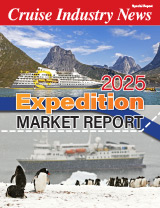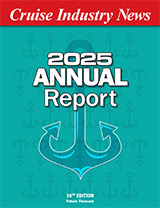Salen Lindblad Cruising and partners, Nippon Yusen Kaisha (NYK Line), Mitsubishi Corporation, Mitsubishi Heavy Industries, and Hapag Lloyd have established a joint venture, Frontier Cruises, for the purpose of building and operating a new expedition-type cruise ship.
According to Yvonne Williams, Executive Vice President of Salen Lindblad, Frontier Cruises the name of the holding company, which will own the ship, which will be marketed under the Salen Lindblad Cruising banner. Mary Connolly, Director of Marketing, said the partners hold equal shares in the company.
Worldwide Marketing
Marketing and sales responsibilities will be shared, however, with Salen Lindblad being responsible for North and South America and the South Pacific; NYK for Japan, where the company expects to generate from 15 to 20 percent of its passengers; and Hanseatic Tours in Europe, where the company expects another 10 to 15 percent of its passengers. Connolly said that while she expected around 75 percent of the passengers to be Americans, she also thought that Australia and New Zealand would be important markets.
New Standard for Expedition Vessels
The yet unnamed 6,700-ton, 164-passenger ship which will be built at a cost of $42 million by Mitsubishi at its Kobe shipyard, will differ significantly from traditional expedition-type vessels. Fully air conditioned and with stabilizers, the new ship will have 82 staterooms, all of which will be outside and will average 194 square feet. Eighteen will have private verandahs; two will be especially designed for wheelchair access; and two will be extra-large suites. All staterooms will have a cozy sitting area, as well as a sleeping area. There will be a crew of 80.
The dining room and the main lounge are planned to accommodate all passengers at one time, offering an open dining and open ship policy.
There will also be a conference room, library, gymnasium with sauna, outdoor deck space on all five decks, and sheltered and heated swimming pool in addition to a dark room and a laboratory.
In summary, this means a much broader market appeal for an expedition vessel, crossing over into the upscale yacht-like cruise ship market.
Twelve Zodiacs and a helicopter stationed on the onboard helipad will enable passengers access to shores where docking facilities do not exist.
Science, Culture and Sports
“Our aim is to offer the high-class quality of a club,” Connolly said, “practicality with every comfort.”
Yet, while the new ship promises to be luxurious in the sense of the upscale cruise ships, it will not offer the regular shipboard entertainment nor gambling. Instead, Salen Lindblad will carry onboard naturalists, botanists, historians and other experts for lectures. As the ship also will carry considerable sports equipment, there will be a sports director onboard for scuba diving and snorkeling. An expedition leader will be onboard each cruise.
“We may also have art exhibits onboard,” Connolly said, “and onboard sessions to complement land tours – even to review tours.”
The new Lindblad vessel will have a cruising speed of 15 knots with a maximum of 17 knots. With super ice class capability, itineraries, which have yet not been finalized, will include cruises to such regions as the Arctic and the Antarctic, as well as the remote areas of the world inaccessible to traditional cruise liners, according to a prepared statement.
Connolly estimated that per diems will be in the range of approximately $450 to $500.
Marketing
As many of the other small cruise companies, Salen Lindblad also relies heavily on direct mail and uses very little advertising, according to Connolly who also said that the company has a strong following among its former passengers.
“We have a past passenger pool of some 33,000 individuals,” said Williams. She also said that among the 240 million population of the United States there are millions who are affluent, have college educations and are ecologically sensitive. “There is a tremendous untapped market for our type of cruises,” she said, pointing to the strong membership rolls of the Sierra Club, the Audubon Society and other organizations.
“We have all done our homework,” Williams said. “In Japan, the government is encouraging the Japanese to take vacations and to spend them abroad. And as a whole, Europe is on its way to become a very strong buying power.”
“The market for expedition-type cruises is definitely growing,” added Connolly, “people are now very environmental minded and increasingly believe that the seas should be preserved and protected. The recent oil spill in Valdez, Alaska, shows you that literally everybody is interested in this now.”
She also said that more people now want a what she called a “real experience.” These are not only the older and well-to-do she said, but also the young and intellectual, and those who are sports oriented and enjoy mountain climbing and scuba diving.
A press kit will be ready within two weeks and the first of two initial brochures will be ready this summer, giving the company a lead time of some 17 to 18 months on its marketing program, before the ship is launched.
Changing and Expanding Market
According to Williams and Connolly, the competition to their new vessel will come from Society Expeditions and Special Expeditions as well as from Cunard Sea Goddess and Seabourn.
“Even though some of these are real luxury vessels,” Connolly said, “they do go into some of the same areas we do, including Western Africa.”
The berth capacity in the traditional expedition market in 1989 is estimated at around 500 with an annual passenger capacity of approximately 14,000 passengers.
In a broader market scope, which also includes yachtlike cruise vessels going to remote areas and ports not accessible for traditional cruise ships, the annual berth capacity increases to almost 1,000 with an annual capacity potential of more than 25,000 passengers.
In addition will be the second Seabourn vessel to be introduced in December of this year and the planned fleet of eight Renaissance vessels for which the marketing strategy may also be overlapping the traditional expedition market.
It is also known that Special Expeditions is looking to add another ship to its worldwide operations.
But as the expedition-type vessels offer more comforts, they are expected to be appealing to yet a broader market base, limited mainly by the price factor.
Perspectives
Most notable in the new ship project is the participation of NYK in addition to the fact that this is only the third vessel to be built in Japan and the second by Mitsubishi for Western passengers.
NYK is the parent company of Crystal Cruises, which is building a 960-passenger ship for the upscale U.S. cruise market, and has confirmed plans for a three ship fleet. NYK also reportedly has entered into a joint venture with UK based John Swire for the building and marketing of a 20,000-ton, 600-passenger ship in the Japanese market.
Salen Lindblad
The new ship follows a long-planned and awaited shipbuilding project in Yugoslavia which remains in suspension (with signed contracts) when the government there withdrew loan grants.
Salen Lindblad Cruising was formed in 1982 and operated the Lindblad Explorer and the Lindblad Polaris until 1984 when the ships were sold. The company has subsequently marketed and operated ships on charter basis and is also general sales agent for other expedition-type and exotic travel.



